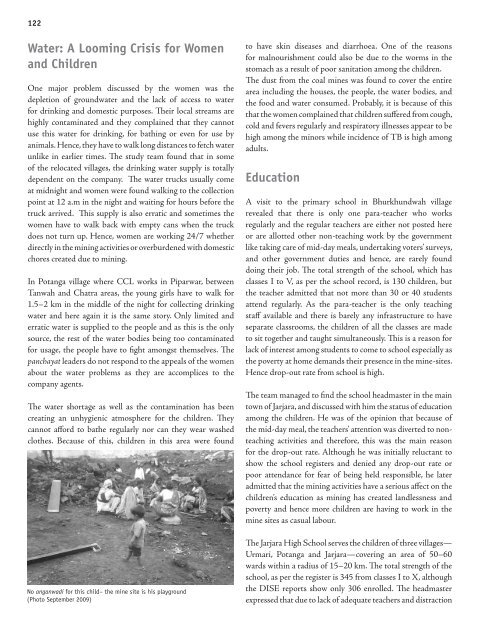Children - Terre des Hommes
Children - Terre des Hommes
Children - Terre des Hommes
You also want an ePaper? Increase the reach of your titles
YUMPU automatically turns print PDFs into web optimized ePapers that Google loves.
122<br />
Water: A Looming Crisis for Women<br />
and <strong>Children</strong><br />
One major problem discussed by the women was the<br />
depletion of groundwater and the lack of access to water<br />
for drinking and domestic purposes. Their local streams are<br />
highly contaminated and they complained that they cannot<br />
use this water for drinking, for bathing or even for use by<br />
animals. Hence, they have to walk long distances to fetch water<br />
unlike in earlier times. The study team found that in some<br />
of the relocated villages, the drinking water supply is totally<br />
dependent on the company. The water trucks usually come<br />
at midnight and women were found walking to the collection<br />
point at 12 a.m in the night and waiting for hours before the<br />
truck arrived. This supply is also erratic and sometimes the<br />
women have to walk back with empty cans when the truck<br />
does not turn up. Hence, women are working 24/7 whether<br />
directly in the mining activities or overburdened with domestic<br />
chores created due to mining.<br />
In Potanga village where CCL works in Piparwar, between<br />
Tanwah and Chatra areas, the young girls have to walk for<br />
1.5–2 km in the middle of the night for collecting drinking<br />
water and here again it is the same story. Only limited and<br />
erratic water is supplied to the people and as this is the only<br />
source, the rest of the water bodies being too contaminated<br />
for usage, the people have to fight amongst themselves. The<br />
panchayat leaders do not respond to the appeals of the women<br />
about the water problems as they are accomplices to the<br />
company agents.<br />
The water shortage as well as the contamination has been<br />
creating an unhygienic atmosphere for the children. They<br />
cannot afford to bathe regularly nor can they wear washed<br />
clothes. Because of this, children in this area were found<br />
No anganwadi for this child– the mine site is his playground<br />
(Photo September 2009)<br />
to have skin diseases and diarrhoea. One of the reasons<br />
for malnourishment could also be due to the worms in the<br />
stomach as a result of poor sanitation among the children.<br />
The dust from the coal mines was found to cover the entire<br />
area including the houses, the people, the water bodies, and<br />
the food and water consumed. Probably, it is because of this<br />
that the women complained that children suffered from cough,<br />
cold and fevers regularly and respiratory illnesses appear to be<br />
high among the minors while incidence of TB is high among<br />
adults.<br />
Education<br />
A visit to the primary school in Bhurkhundwah village<br />
revealed that there is only one para-teacher who works<br />
regularly and the regular teachers are either not posted here<br />
or are allotted other non-teaching work by the government<br />
like taking care of mid-day meals, undertaking voters’ surveys,<br />
and other government duties and hence, are rarely found<br />
doing their job. The total strength of the school, which has<br />
classes I to V, as per the school record, is 130 children, but<br />
the teacher admitted that not more than 30 or 40 students<br />
attend regularly. As the para-teacher is the only teaching<br />
staff available and there is barely any infrastructure to have<br />
separate classrooms, the children of all the classes are made<br />
to sit together and taught simultaneously. This is a reason for<br />
lack of interest among students to come to school especially as<br />
the poverty at home demands their presence in the mine-sites.<br />
Hence drop-out rate from school is high.<br />
The team managed to find the school headmaster in the main<br />
town of Jarjara, and discussed with him the status of education<br />
among the children. He was of the opinion that because of<br />
the mid-day meal, the teachers’ attention was diverted to nonteaching<br />
activities and therefore, this was the main reason<br />
for the drop-out rate. Although he was initially reluctant to<br />
show the school registers and denied any drop-out rate or<br />
poor attendance for fear of being held responsible, he later<br />
admitted that the mining activities have a serious affect on the<br />
children’s education as mining has created landlessness and<br />
poverty and hence more children are having to work in the<br />
mine sites as casual labour.<br />
The Jarjara High School serves the children of three villages—<br />
Urmari, Potanga and Jarjara—covering an area of 50–60<br />
wards within a radius of 15–20 km. The total strength of the<br />
school, as per the register is 345 from classes I to X, although<br />
the DISE reports show only 306 enrolled. The headmaster<br />
expressed that due to lack of adequate teachers and distraction






